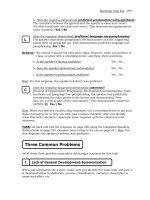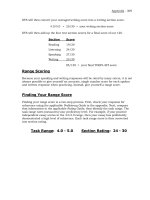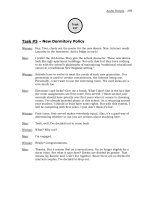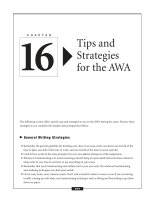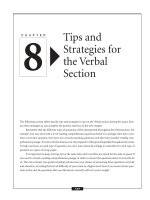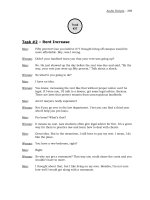Tips and Strategies for the AWA
Bạn đang xem bản rút gọn của tài liệu. Xem và tải ngay bản đầy đủ của tài liệu tại đây (149.75 KB, 37 trang )
The following section offers specific tips and strategies to use on the AWA during the exam. Practice these
strategies as you complete the sample essay prompts that follow.
General Writing Strategies
■
Remember the general guideline for dividing your time on an essay exam: use about one-fourth of the
time to plan, one-half of the time to write, and one-fourth of the time to revise and edit.
■
Look for key words in the essay prompt to be sure you address all aspects of the assignment.
■
The key to brainstorming is to avoid censoring yourself. Keep an open mind and write down whatever
ideas come to you. You do not have to use everything in your essay.
■
Remember that your brainstorming and outline are for your eyes only. Use whatever brainstorming
and outlining techniques you find most useful.
■
On an essay exam, every minute counts. Don’t wait around for ideas to come to you. If you are having
trouble coming up with ideas, use brainstorming techniques such as listing and freewriting to get ideas
down on paper.
CHAPTER
Tips and
Strategies
for the AWA
16
267
■
A good thesis makes an assertion about the topic; it does not just repeat the topic or ask a question.
Make sure your thesis takes a clear position on the issue or argument.
■
Your planning time is probably the most crucial part of an essay exam. Create a detailed outline to
organize your ideas. Revise your outline before you begin writing to make sure you have sufficient sup-
port and specific examples and that you have addressed all of the elements in the prompt.
■
Make sure you have at least two or three supporting ideas for your thesis. If no other organizational
pattern makes sense, put them in order of importance, with your most important idea last.
■
Remember, it’s important to get going and keep moving. If you can’t think of the exact word or phrase
you are looking for, approximate. You can come back to fix it later if you have time. For now, writing
something that is close enough must be good enough so you can get the rest of your ideas down.
■
Remember to keep it simple. Your time is limited, and your readers will be looking for basic structural
and organizational elements. Don’t worry about impressing your readers with sophisticated organiza-
tion or style; you don’t need anything out of the ordinary to impress your readers. A formulaic but
clear essay will do better than one that is overly complex.
■
Remember that first impressions are important, but it’s more important to finish your essay. Don’t get
hung up trying to write a perfect introduction. Simply summarize the argument or issue and state your
thesis. If you have time later, you can come back and write a catchier introduction.
■
Signpost, signpost, signpost. Use strong transitions throughout your essay to make the relationships
between ideas clear. Remember that both your human reader and E-rater® will be looking for these
guides.
■
A specific fact or detail has more power than a general statement. Include specific examples whenever
possible.
■
In general, unless you have less than five minutes left, revise first and then edit. Save your grammar and
spelling check until after you have made “big picture” changes to your essay. If you are nearly out of
time, read through your essay quickly and make any revisions or editorial changes.
■
If a sentence seems unclear to you, it may be that you are trying to do too much in one sentence. Try
breaking it up into two simpler sentences that are more clear.
■
Remember the guidelines for effective style: be precise, be concise, use the active voice, vary the sen-
tence structure, and avoid jargon and pretentious language. Make sure you use an appropriate level of
formality and a serious, respectful tone throughout your essay.
■
Correct punctuation is important, but don’t get hung up on trying to determine whether you need a
comma or a semicolon. Make your choice quickly and move on to the next issue.
■
If you are unsure about capitalization, ask yourself whether the word in question is something specific
or general. If it is a specific person, place, or thing, then it probably should be capitalized. Remember, in
this regard, specific means particular or individual, not detailed. For example, a poodle is a specific type
of dog, but it is not capitalized because it doesn’t refer to a specific (individual or particular) dog.
Rover, however, should be capitalized because Rover is a specific (individual or particular) dog.
■
If you have the time, read your essay backward line by line. This will enable you to spot errors that you
might miss reading straight through.
–
TIPS AND STRATEGIES FOR THE AWA
–
268
Analyzing the Issue
■
Remember that in the Analysis of an Issue essay, there is no correct answer. A good essay will take a
clear position and support that position. Don’t be afraid to say what you think. Just be sure to back up
your opinion.
■
A strong issue essay will address counterarguments. Take a minute to imagine how someone taking the
opposite point of view would support that position. Acknowledge key concerns and then show why
your position has more merit.
Analyzing the Argument
The argument you are presented with on the GMAT exam may have many different problems. To address all
of the different possibilities, break down your analysis into two steps: (1) what the argument has and (2) what
it might be missing:
1. What is already there? Check the premises and conclusion. Are the premises (stated and unstated)
logical? Do they lead logically to the conclusion? Is the evidence strong and convincing? Are there any
fallacies in the argument?
2. What might be missing? What alternative explanations or counterarguments are missing from the
argument? What evidence would strengthen the conclusion? What missing information would help
you better evaluate the argument?
–
TIPS AND STRATEGIES FOR THE AWA
–
269
The following practice section contains ten prompts for the Analysis of an Issue section and ten prompts for
the Analysis of an Argument section. Use these prompts to practice your timed writing skills for the AWA.
Give yourself 30 minutes for each essay. Sample essay responses are provided after the sample prompts.
To create a realistic testing scenario, it is important that you do not read the prompts until you are ready
to begin your timed session. Even a quick glance at the topic will give you the opportunity to start develop-
ing ideas for an essay. Remember, you will not have any incubation period on the GMAT® exam; you will only
receive your topic when your timed writing session begins.
You will have to write two essays in a row on the GMAT exam, so practice doing one of each kind of
essay consecutively. The first few times you may find that you lose steam on the second essay; after all, writ-
ing two essays in just one hour is hard work. But the more you practice, the easier it will become, and the more
comfortable you will be with pacing yourself through the writing process.
It is also critical that you use a computer with a basic word processor to practice writing the essays. You
will not have the option of writing the essays by hand on the AWA, so you must be comfortable composing
and revising on the computer. Be sure to turn off the spell check and grammar check; the word-processing
program on the GMAT exam will not include either of these features. Have several sheets of scratch paper
available so that you can brainstorm and outline your essays.
CHAPTER
AWA
Practice
17
271
Analysis of an Issue Sample Prompts
1. A leader who is respected is more powerful than one who is feared.
Discuss the extent to which you agree or disagree with this opinion. Support your position with
reasons and/or examples from your own experience, observations, or reading. Complete your essay in
30 minutes.
–
AWA PRACTICE
–
272
2. The main goal of education should be to teach students to be good citizens, not to prepare them for the
workplace.
Discuss the extent to which you agree or disagree with this opinion. Support your position with
reasons and/or examples from your own experience, observations, or reading. Complete your essay in
30 minutes.
–
AWA PRACTICE
–
273
3. One of the problems with our society is that we have created such a large divide between the home and the
workplace. Even if people bring their work home from the office, their professional life has little connection
to their home life.
Discuss the extent to which you agree or disagree with this opinion. Support your position with
reasons and/or examples from your own experience, observations, or reading. Complete your essay in
30 minutes.
–
AWA PRACTICE
–
274
4. Every employee deserves a certain amount of privacy in the workplace, whether that means a private office
or cubicle or the ability to make private phone calls or send personal e-mails.
Discuss the extent to which you agree or disagree with this opinion. Support your position with
reasons and/or examples from your own experience, observations, or reading. Complete your essay in
30 minutes.
–
AWA PRACTICE
–
275
5. Without competition, people stop trying to improve and become complacent. Competition is therefore good
for individuals and businesses alike.
Discuss the extent to which you agree or disagree with this opinion. Support your position with
reasons and/or examples from your own experience, observations, or reading. Complete your essay in
30 minutes.
–
AWA PRACTICE
–
276
6. Success requires sacrifice. You cannot be successful in your professional life without sacrificing something in
your personal life.
Discuss the extent to which you agree or disagree with this opinion. Support your position with
reasons and/or examples from your own experience, observations, or reading. Complete your essay in
30 minutes.
–
AWA PRACTICE
–
277
7. Art reminds us of our humanity and connection to others. We all need some form of art in our lives to keep
us human.
Explain what you think is meant by the previous statement and discuss the extent to which you
agree or disagree with this opinion. Support your position with reasons and/or examples from your
own experience, observations, or reading. Complete your essay in 30 minutes.
–
AWA PRACTICE
–
278
8. A creative person can succeed, but not without diligence. Diligence is the most important factor in success.
Discuss the extent to which you agree or disagree with this opinion. Support your position with
reasons and/or examples from your own experience, observations, or reading. Complete your essay in
30 minutes.
–
AWA PRACTICE
–
279
9. Today’s highest paid teachers are those who teach high school and college students. But the most important
years in a human being’s educational development are the earliest years. Therefore, early childhood educa-
tors should receive the highest salaries.
Discuss the extent to which you agree or disagree with this opinion. Support your position with
reasons and/or examples from your own experience, observations, or reading. Complete your essay in
30 minutes.
–
AWA PRACTICE
–
280
